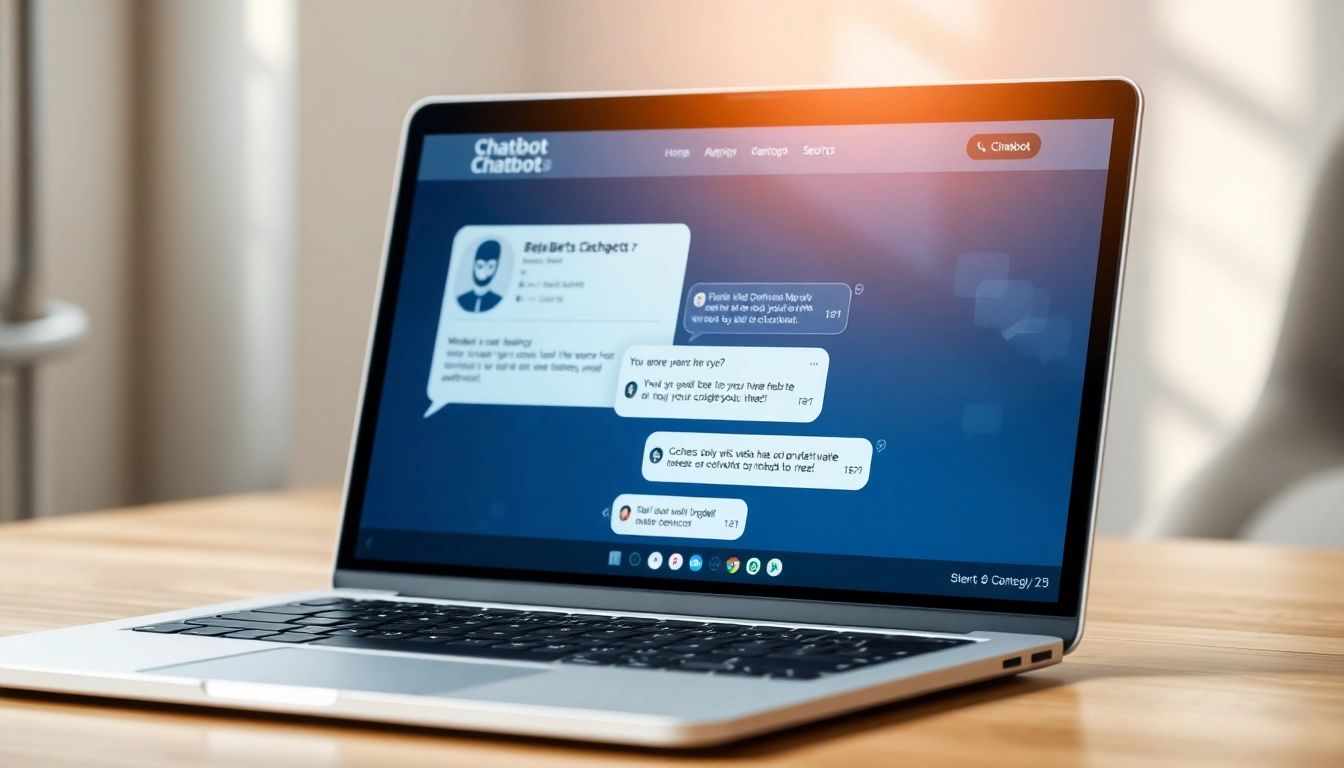Understanding the Benefits of a Chatbot for Website Engagement
In today’s digital age, businesses are constantly seeking innovative ways to enhance customer engagement and streamline service delivery. One such innovation is the integration of a chatbot for website functionality. Chatbots have revolutionized interactions between businesses and their customers, automating responses, offering personalized assistance, and significantly improving user experiences. This article delves deep into the myriad benefits of deploying a chatbot on your website, elucidating how they work, and presenting real-world examples to illustrate their impact.
What is a Chatbot and How Does It Work?
A chatbot is a software application designed to simulate human conversation through voice commands or text chats. Equipped with artificial intelligence (AI), chatbots can understand and respond to inquiries, perform tasks, and provide information quickly and efficiently. They work by utilizing natural language processing (NLP) algorithms to comprehend user inputs and generate appropriate replies. Chatbots can be found on websites, in messaging applications, or integrated into customer service platforms, catering to users’ needs at any time of the day.
Key Advantages of Implementing a Chatbot
The advantages of implementing a chatbot on your website are extensive:
- 24/7 Availability: Chatbots are available around the clock, offering instant support to customers irrespective of time zones, which can significantly enhance user satisfaction.
- Cost Efficiency: By automating routine inquiries and support tasks, businesses can reduce operational costs associated with hiring additional staff for customer service roles.
- Improved User Engagement: Chatbots can initiate conversations, ask questions, and engage visitors in real time, creating a more dynamic and interactive user experience.
- Personalization: Advanced chatbots can analyze user behavior to provide tailored responses and recommendations, enhancing the customer journey.
- Data Collection: Chatbots can gather valuable insights about user preferences and behaviors, helping businesses refine their offers and improve service.
Real-World Examples of Chatbots in Action
Many companies have leveraged chatbots successfully to enhance their customer experiences. For example:
- Sephora: This beauty retailer employs a chatbot that offers personalized product recommendations and beauty tips based on users’ queries, thereby creating a unique and engaging shopping experience.
- H&M: The fashion retailer’s chatbot helps users navigate through their inventory, suggesting outfits based on user preferences and styles.
- Bank of America: Their “Erica” chatbot provides banking assistance, transaction updates, and financial advice, making banking more accessible and user-friendly.
Choosing the Right Chatbot for Your Website
Selecting the right chatbot solution is crucial for maximizing engagement and transforming user interactions into meaningful relationships. With various options available in the market, it’s essential to understand the factors that influence their effectiveness.
Factors to Consider When Selecting a Chatbot
When choosing a chatbot for your website, consider the following factors:
- Purpose: Define the primary goals your chatbot should achieve, whether it’s for customer service, sales, or both.
- Integration: Ensure the chatbot can easily integrate with your existing systems and platforms, including CRM and e-commerce solutions.
- User Experience: Opt for a chatbot that offers a seamless and engaging user experience, ensuring that interactions feel natural and responsive.
- AI Capabilities: Evaluate the intelligence of the chatbot—those equipped with NLP and machine learning tend to provide more accurate and context-aware responses.
- Scalability: Choose a solution that can scale alongside your business, accommodating growth and increased user engagement.
Comparing Different Chatbot Solutions
To effectively choose a chatbot, it is beneficial to compare various chatbot solutions:
- Rule-Based vs. AI-Powered: Rule-based chatbots follow predefined scripts but are limited in adaptability. In contrast, AI-powered chatbots can learn from interactions and improve over time.
- Visitor Targeting: Some chatbots are designed to engage visitors who exhibit specific behaviors, while others focus on broader interactions. Identify which approach aligns best with your marketing strategies.
- Cost: Weigh the pricing models of different chatbot platforms—some may charge per user or interaction, while others offer flat rates. Determine what works best for your budget.
User Experience Considerations for Integration
Integrating a chatbot into your website should enhance the user experience rather than complicate it. Focus on:
- Accessibility: Ensure the chatbot is easily visible and can be accessed across all devices, including mobile and desktop.
- Intuitive Design: The chatbot interface should be user-friendly, enabling users to navigate without difficulty.
- Proactive Engagement: Consider programming your chatbot to initiate interactions based on user activity, such as site navigation or time spent on specific pages.
Quick Setup Guide for Your Website Chatbot
Implementing a chatbot on your website can be straightforward if you follow the right steps. Here’s a quick guide that outlines the installation and configuration process.
Step-by-Step Installation Process
The installation of a chatbot generally follows these steps:
- Choose a Platform: Select a chatbot platform that aligns with your business needs. Popular options include Chatfuel, ManyChat, and Tidio.
- Create an Account: Sign up for an account on your chosen platform and explore its features.
- Build Your Chatbot: Use the platform’s builder to create the chatbot’s conversational flows. This can involve programming greetings, FAQs, and user prompts.
- Integrate with Your Website: Follow the specific instructions to integrate the chatbot with your website, typically done through a simple copy-paste of code into your site’s HTML.
- Test the Chatbot: Before going live, thoroughly test the chatbot to ensure it responds appropriately and meets user expectations.
Customizing Your Chatbot for Optimal Performance
Customization enhances the effectiveness of a chatbot. Consider the following to optimize its performance:
- Define User Personas: Tailor the chatbot’s language and interactions to resonate with your target audience.
- Monitor Interactions: Utilizing analytics to observe how users interact with the chatbot can guide adjustments to their conversational design.
- Use Personalized Messaging: Integrate user data to personalize responses, creating a tailored experience for every user.
Common Pitfalls to Avoid During Implementation
Despite the straightforward implementation process, there are common pitfalls to avoid:
- Over-Complexity: Avoid creating overly complex flows that confuse users. Keep it simple and focused on your primary objectives.
- Neglecting Regular Updates: Failing to update the chatbot with new information and responses may lead to outdated interactions.
- Ignoring User Feedback: Ensure you continually gather and analyze user feedback to refine and enhance the chatbot’s effectiveness.
Maximizing the Effectiveness of Your Chatbot
Once your chatbot is live, maximizing its effectiveness is crucial to achieving engaged users and satisfied customers. Here are best practices to consider.
Best Practices for Engaging Users through Chatbots
To foster an engaging environment through your chatbot, consider the following best practices:
- Personalization: Use information from user profiles or previous interactions to customize conversations and ensure relevance.
- Friendly Tone: Implement a friendly and approachable tone in the chatbot’s communication, as this can make users feel more comfortable.
- Quick Responses: Ensure the chatbot provides responses as quickly as possible, as delayed responses can lead to frustration.
Utilizing Analytics to Measure Chatbot Performance
Leverage analytics tools to track the performance of your chatbot:
- Engagement Metrics: Analyze metrics such as user interaction rates, session durations, and conversation completion rates to gauge effectiveness.
- User Feedback: Collect direct feedback from users regarding their experiences with the chatbot to identify improvement areas.
- Conversion Rates: Monitor how well the chatbot converts interactions into completed sales or lead generation, allowing for performance assessment against business objectives.
Iterating Based on User Feedback and Data
Continuously iterating your chatbot design based on user feedback is paramount for long-term success. Here’s how to do it effectively:
- Regular Updates: Schedule regular updates to the chatbot’s database based on the latest user feedback and insights from analysis.
- A/B Testing: Experiment with different conversational flows and approaches to see which yield better engagement and satisfaction.
Future Trends in Chatbot Technology for Websites
The chatbot landscape is continually evolving, driven by advancements in technology and changing customer expectations. Here, we discuss anticipated future trends.
Predicted Developments in Chatbot Functionality
As technology progresses, chatbot functionality is expected to advance significantly:
- Enhanced Natural Language Processing: Improvements in NLP will enable chatbots to understand and respond to complex inquiries more effectively.
- Voice-Enabled Interactions: The integration of voice technology will allow users to communicate with chatbots verbally, leading to a more intuitive user experience.
Integrating AI Capabilities for Enhanced User Interactions
The incorporation of artificial intelligence will lead to smarter chatbots capable of adapting to user preferences and behaviors:
- Machine Learning Algorithms: These algorithms will allow chatbots to learn from their interactions, improving their responses and predictions over time.
- Sentiment Analysis: Chatbots equipped with sentiment analysis capabilities will be able to gauge user emotions and adjust their responses accordingly, enhancing user satisfaction.
The Role of Chatbots in Customer Support Evolution
Chatbots are set to become integral components of customer support strategies:
- Automated Support: As chatbots handle more routine inquiries, they will free up human agents to tackle more complex issues, leading to improved service efficiency.
- 24/7 Support Solutions: Chatbots will continue to provide round-the-clock support, ensuring customer queries are addressed promptly irrespective of the hour.
Conclusion
The integration of a chatbot for your website can fundamentally transform how businesses interact with customers, driving engagement and improving overall user satisfaction. By understanding the functionalities, benefits, and implementation strategies of chatbots, businesses can create a user-centered approach that meets customer needs in real-time. As technology continues to evolve, those who adapt and integrate advanced chatbot functionalities will likely stand out in the competitive landscape, harnessing the potential of this innovative technology to drive growth and enhance customer experiences.



